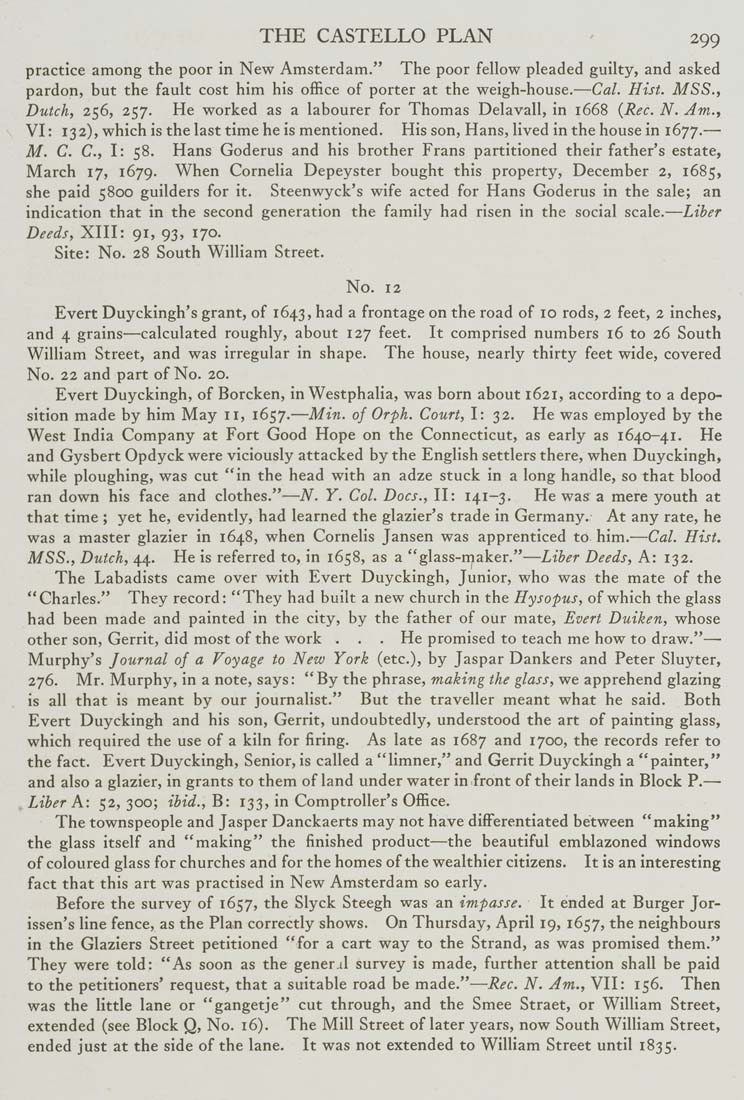THE CASTELLO PLAN 299
practice among the poor in New Amsterdam." The poor fellow pleaded guilty, and asked
pardon, but the fault cost him his office of porter at the weigh-house.—Cal. Hist. MSS.,
Dutch, 256, 257. He worked as a labourer for Thomas Delavall, In 1668 (Rec. N. Am.,
VI: 132), which is the last time he is mentioned. His son, Hans, lived in the house In 1677.—
M. C. C, I; 58. Hans Goderus and bis brother Frans partitioned their father's estate,
March 17, 1679. When Cornelia Depeyster bought this property, December 2, 1685,
she paid 5800 guilders for It. Steenwyck's wife acted for Hans Goderus In the sale; an
indication that in the second generation the family had risen in the social scale.—Liber
Deeds, XIII: 91, 93, 170.
Site: No. 28 South William Street.
No. 12
Evert Duyckingh's grant, of 1643, had a frontage on the road of 10 rods, 2 feet, 2 Inches,
and 4 grains—calculated roughly, about 127 feet. It comprised numbers 16 to 26 South
William Street, and was irregular in shape. The house, nearly thirty feet wide, covered
No. 22 and part of No. 20.
Evert Duyckingh, of Borcken, in Westphalia, was born about 1621, according to a depo¬
sition made by him May 11, 1657.—Min. of Orph. Court, I; 32. He was employed by the
West India Company at Fort Good Hope on the Connecticut, as early as 1640-41. He
and Gysbert Opdyck were viciously attacked by the English settlers there, when Duyckingh,
while ploughing, was cut "In the head with an adze stuck in a long handle, so that blood
ran down his face and clothes."—N. Y. Col. Docs., II: 141-3. He was a mere youth at
that time ; yet he, evidently, had learned the glazier's trade in Germany. At any rate, he
was a master glazier in 1648, when Cornelis Jansen was apprenticed to him.—Cal. Hist.
MSS., Dutch, 44. He is referred to. In 1658, as a "glass-rnaker."—Liber Deeds, A: 132.
The Labadists came over with Evert Duyckingh, Junior, who was the mate of the
"Charles." They record; "They had built a new church in the Hysopus, of which the glass
had been made and painted In the city, by the father of our mate. Evert Duiken, whose
other son, Gerrit, did most of the work . . . He promised to teach me how to draw."—
Murphy's Journal of a Voyage to New York (etc.), by Jaspar Dankers and Peter Sluyter,
276. Mr. Murphy, in a note, says; "By the phrase, making the glass, we apprehend glazing
is all that is meant by our journalist." But the traveller meant what he said. Both
Evert Duyckingh and his son, Gerrit, undoubtedly, understood the art of painting glass,
which required the use of a kiln for firing. As late as 1687 and 1700, the records refer to
the fact. Evert Duyckingh, Senior, is called a "limner," and Gerrit Duyckingh a "painter,"
and also a glazier. In grants to them of land under water in front of their lands in Block P.—
Liber A: 52,300; ibid.,B: 133, in Comptroller's Office.
The townspeople and Jasper Danckaerts may not have differentiated between "making"
the glass itself and "making" the finished product—the beautiful emblazoned windows
of coloured glass for churches and for the homes of the wealthier citizens. It is an interesting
fact that this art was practised in New Amsterdam so early.
Before the survey of 1657, the Slyck Steegh was an impasse. It ended at Burger Jor-
issen's line fence, as the Plan correctly shows. On Thursday, April 19, 1657, the neighbours
in the Glaziers Street petitioned "for a cart way to the Strand, as was promised them."
They were told; "As soon as the gener.il survey is made, further attention shall be paid
to the petitioners' request, that a suitable road be made."—Rec. N. Am., VII: 156. Then
was the little lane or "gangetje" cut through, and the Smee Straet, or William Street,
extended (see Block Q, No. 16). The Mill Street of later years, now South William Street,
ended just at the side of the lane. It was not extended to William Street until 1835.
|








